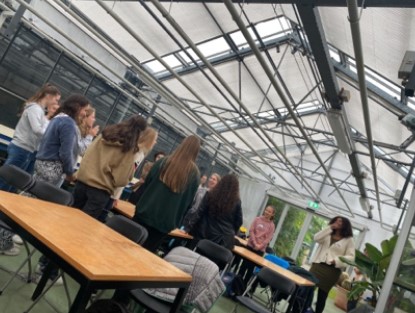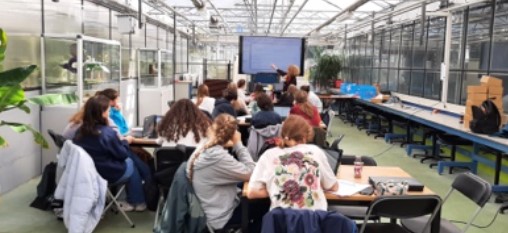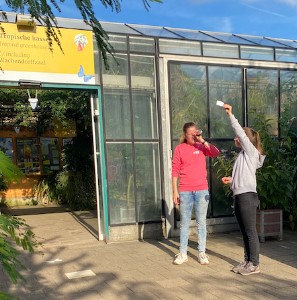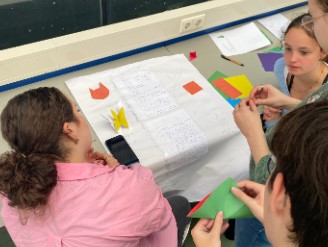Organized by Utrecht University in Netherlands
Background
Utrecht University organised the Autumn Days for Girls from October 24-26, 2022. Three days of challenging STEM-related activities were carried out around three larger themes:
- The Trees Monday Assignment: measuring and calculating trees, practical ‘exciting surfaces’ and drawing a pythagorean tree;
- The Eye Tuesday Assignment: eye-tracking, medical physical research on eyes and building and using a camera obscura; and
- The Design Wednesday Assignment: mathematical folds, pseudo-coding and heights.
Each day there was a new Girl of the Day presenting her work and a female speaker combining a workshop with a super interesting presentation. On the last day, as a group activity, the physics topics around forces, gravity and altitude were combined with a climbing workshop!


The Programme
Twenty girls attended the Autumn Days, on the Campus of the Utrecht University, with a base camp in the Botanic Garden.
Our entrepreneural focus for all day assignments had the following characteristic: The instruction for the activities was not an extended version. There were more or less open contexts with some general question, but not with a method. The girls had to find out a number of subsequent steps to come to a product. This is really different from a normal school situation.
These ‘out-of-the-school’-activities were combined with a special focus on ‘hands-on’ technology.
So not only working with computer screens and programs, but working with design and handson activities: Folding mathematical structures; Building your own camera obscura., and a more ‘high-brow’ activity was focused on (software for) eye tracking.
More details of each assignment:
The Trees Monday Assignment: Pictures of different trees; Measuring height and diameter; Volume calculation of trees; Surface of a leave; How many leaves are there on one tree? Calculation rule ‘da Vinci’, can you measure from a real tree? Pythagoras trees; The shape of a water drop on a leave;
Identification of a hydrofile/hydrofobe leave.
The Eye Tuesday Assignment: in the morning a short presentation : Eye anatomy, eye movements.
Students are first given an assignment on paper. In it, they are going to measure the distance and speed of eye movements (between the points of a measurement). As a follow-up, they solve the formula in this assignment. After this, they start programming. Anna has written a code, but certain parts are left out (if-loops etc. not while-loops! Figure out the mathematical connection and not the programming-moderate connection). The task is to fill it in. They have to fill in the same/similar formula as solved in the previous assignment. We are programming in matlab/octava.
Calculate distance and speed of eye movements in coordinate system (simple dataset, without computer on paper). Program activity: Adapt the Octave code: differences between saccades and fixations.
The Design Wednesday Assignment:
On paper, origami has little affinity with the scientific world. But in practice, a far-reaching intertwining of the folding technique and mathematics takes place. This led to applications that even prove useful in space travel. So, the girls were guided this morning by a PhD from the Freudenthal Institute, and they designed different folded objects with questions about what they were actually doing.
Feedback
Feedback from the pre-questionnaire:
- ‘What job later’: beta side, Maths teacher, Something with design of engineering, 3 times ‘doctor/surgeon/pediatrician’, Vet, Something with environment, Quantum physics and 4 times ‘I don’t know’.
- people find it predominantly important and interesting, no obvious differences between subjects (at most biology is seen as ‘slightly more fun/interesting’).
- follow-up studies are scored strongly towards ‘fascinating’ and ‘appeal to me’.
And from the Post questionnaire
- Among the first 7 ‘opinion questions’ (with 5-point scale, see questionnaire used), the most striking stands out: “Can I imagine myself working in the STEM field?” -> very much agree!
- Question 8 with some sub-questions on opinion of STEM subjects at school and further studies in STEM is answered somewhat neutrally
- For question 9 ‘How did you hear about this autumn camp’: mainly through the teacher and a school advertisement
- For question 10 ‘Why did you participate in this autumn camp?’: mainly ‘I am interested in STEM subjects’.
- 11. Did you like the autumn camp? -> 9 girls ‘yes’ and 6 girls ‘mostly yes’
- 12. Did you feel comfortable -> 13 yes, 1 mostly yes and 1 sometimes
- 13. Did you think differently about STEM subjects thanks to this autumn camp? -> 9 girls ‘a little’, 6 ‘no’


